翻译评析:第二十二届韩素音青年翻译奖竟赛汉译英译文和译文评析 1
韩素音青翻译奖赛中文原文及参考译文和解析
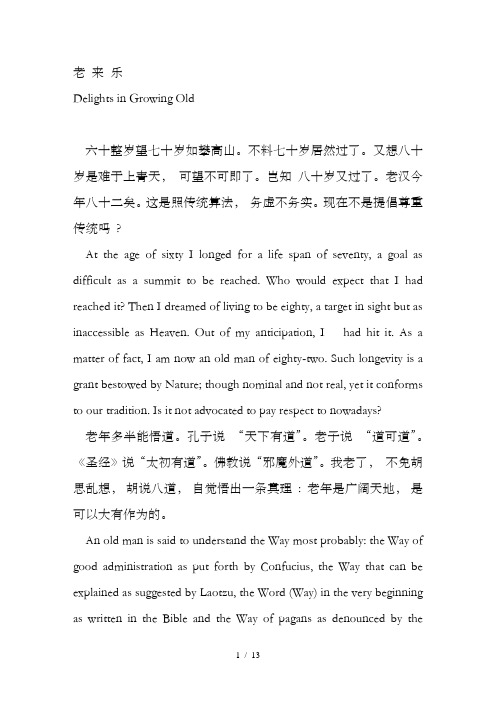
老来乐Delights in Growing Old六十整岁望七十岁如攀高山。
不料七十岁居然过了。
又想八十岁是难于上青天,可望不可即了。
岂知八十岁又过了。
老汉今年八十二矣。
这是照传统算法,务虚不务实。
现在不是提倡尊重传统吗?At the age of sixty I longed for a life span of seventy, a goal as difficult as a summit to be reached. Who would expect that I had reached it? Then I dreamed of living to be eighty, a target in sight but as inaccessible as Heaven. Out of my anticipation, I had hit it. As a matter of fact, I am now an old man of eighty-two. Such longevity is a grant bestowed by Nature; though nominal and not real, yet it conforms to our tradition. Is it not advocated to pay respect to nowadays?老年多半能悟道。
孔子说“天下有道”。
老子说“道可道”。
《圣经》说“太初有道”。
佛教说“邪魔外道”。
我老了,不免胡思乱想,胡说八道,自觉悟出一条真理: 老年是广阔天地,是可以大有作为的。
An old man is said to understand the Way most probably: the Way of good administration as put forth by Confucius, the Way that can be explained as suggested by Laotzu, the Word (Way) in the very beginning as written in the Bible and the Way of pagans as denounced by theBuddhists. As I am growing old, I can't help being given to flights of fancy and having my own Way of creating stories. However I have come to realize the truth: my old age serves as a vast world in which I can still have my talents employed fully and developed completely.七十岁开始可以诸事不做而拿退休金,不愁没有一碗饭吃,自由自在,自得其乐。
历届韩素音翻译大奖赛竞赛原文及译文
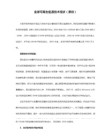
历届韩素音翻译大奖赛竞赛原文及译文英译汉部分 (3)Beauty (excerpt) (3)美(节选) (3)The Literature of Knowledge and the Literature of Power byThomas De Quincey (8)知识文学与力量文学托马斯.昆西 (8)An Experience of Aesthetics by Robert Ginsberg (11)审美的体验罗伯特.金斯伯格 (11)A Person Who Apologizes Has the Moral Ball in His Court by Paul Johnson (14)谁给别人道歉,谁就在道义上掌握了主动保罗.约翰逊 (14)On Going Home by Joan Didion (18)回家琼.狄迪恩 (18)The Making of Ashenden (Excerpt) by Stanley Elkin (22)艾兴登其人(节选)斯坦利.埃尔金 (22)Beyond Life (28)超越生命[美] 卡贝尔著 (28)Envy by Samuel Johnson (33)论嫉妒[英]塞缪尔.约翰逊著 (33)中译英部分 (37)在义与利之外 (37)Beyond Righteousness and Interests (37)读书苦乐杨绛 (40)The Bitter-Sweetness of Reading Yang Jiang (40)想起清华种种王佐良 (43)Reminiscences of Tsinghua Wang Zuoliang (43)歌德之人生启示宗白华 (45)What Goethe's Life Reveals by Zong Baihua (45)怀想那片青草地赵红波 (48)Yearning for That Piece of Green Meadow by Zhao Hongbo (48)可爱的南京 (51)Nanjing the Beloved City (51)霞冰心 (53)The Rosy Cloud byBingxin (53)黎明前的北平 (54)Predawn Peiping (54)老来乐金克木 (55)Delights in Growing Old by Jin Kemu (55)可贵的“他人意识” (58)Calling for an Awareness of Others (58)教孩子相信 (61)To Implant In Our Children’s Young Hearts An Undying Faith In Humanity (61)英译汉部分Beauty (excerpt)美(节选)Judging from the scientists I know, including Eva and Ruth, and those whom I've read about, you can't pursue the laws of nature very long without bumping撞倒; 冲撞into beauty. “I don't know if it's the same beauty you see in the sunset,”a friend tells me, “but it feels the same.”This friend is a physicist, who has spent a long career deciphering破译(密码), 辨认(潦草字迹) what must be happening in the interior of stars. He recalls for me this thrill on grasping for the first time Dirac's⑴equations describing quantum mechanics, or those of Einstein describing relativity. “They're so beautiful,” he says, “you can see immediately they have to be true. Or at least on the way toward truth.” I ask him what makes a theory beautiful, and he replies, “Si mplicity, symmetry .对称(性); 匀称, 整齐, elegance, and power.”我结识一些科学家(包括伊娃和露丝),也拜读过不少科学家的著作,从中我作出推断:人们在探求自然规律的旅途中,须臾便会与美不期而遇。
译文要译出原作的风格_第十二届_韩素音青年翻译奖_汉译英参赛译文评析
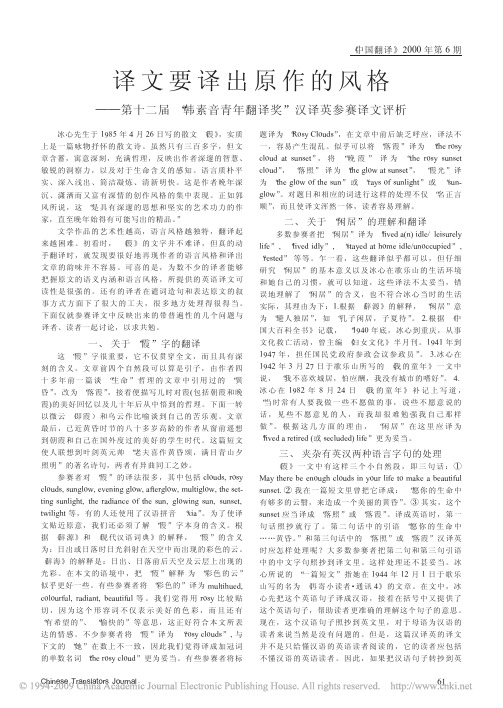
五、文化因素的处理
原文中的文化因素给译者带来一定的障碍, 甚 至 是 难以逾越 的 障 碍 , 但 同 时 也 给 译 者 创 造 了 自 由 驰 骋 的 空 间,提供 展 示 自 己 灵 活 主 动 地 驾 驭 语 言 处 理 文 化 因 素 的 能力的机 会 。 “ 夕阳无限好,只是近黄昏”是唐朝大诗 人李商隐 ( 乐游原》一诗中的名句。 “ 当诗 MBNOMPM ) 《 人登上古 原 , 极 目 西 天 , 但 见 霞 光 夕 照 , 乱 山 明 灭 , 俯 视长安城 阙 , 帝 宫 参 差 , 烟 霭 迷 茫 , 真 是 美 不 胜 收 ! 诗 人不禁发 出 ‘ 夕阳无限好’的深心赞叹。但 ‘ 从来尤物 难流连’ ,韶华易逝,好景难再,因而当这种审美愉悦刚 一浮现,浓重的伤感便罩上心头,发出了 ‘ 只是近黄昏’ 的感 叹 。 ”;吴 熊 和 主 编 : 《 唐 宋 诗 词 评 析 词 典 》 :’A?PQRC’ 吴乔在 《 围炉诗话》中说: “ ‘ 夕阳无限好,只是近黄 昏’ ,比也。 ”施补华也说: “ 叹老之意极矣,然只说夕 阳,并不说自己,所以为妙……此亦比兴也。 ” 对于中国 读者来说 , 这 两 句 诗 可 以 说 家 喻 户 晓 , 不 难 理 解 , 可 以 引起许多 联 想 和 无 限 感 叹 。 由 于 已 有 许 多 人 翻 译 过 , 所 以在 《 霞》中,把它们译成英语应该说不是很难的事情。 参赛译文对这两句诗的处理多有不同。 ! 有些参赛者只 是根据自 己 的 理 解 译 成 英 语 , 把 诗 句 的 意 思 与 其 他 句 子 的意思融合在一起,不加引号,不加解释或脚注。 " 多 数参赛者 译 出 其 意 思 , 并 放 在 引 号 中 , 但 不 加 说 明 或 脚 注。 # 有些参赛者将其译成英语,放在引号中,并用脚 注对诗人 及 诗 的 背 景 作 了 简 要 的 说 明 。 冰 心 不 仅 在 这 里 引用了这两句诗,在 《 我的老伴— — —吴 文 藻 》 一 文 中 , 在谈到她丈夫快去世的时候,也引用过, “ ‘ 夕阳无限 好,只是近黄昏 ’ ,这是天然规律。 ”看来,在讨论生命 及其意义 时 , 这 两 句 诗 并 不 是 无 足 轻 重 的 。 因 为 是 冰 心 从古人那里引用的,在这里又有其特殊含义和文化内涵, 所以参赛 者 的 第 一 种 处 理 方 法 不 算 太 好 。 第 二 种 处 理 方 法虽然加了引号,这对于外国读者来说还是不知所云, 不能引起 足 够 的 联 想 , 不 能 达 到 “ 搭桥”和沟通文化的 目的。第 三 种 处 理 方 法 是 比 较 好 的 。 如 前 所 说 , 冰 心 的 语言质朴 平 实 , 凝 练 明 快 , 如 果 在 译 文 中 加 了 许 多 背 景 知识和解 释 性 的 内 容 , 就 会 使 译 文 失 去 原 作 的 风 格 和 韵 味。因此 , 用 脚 注 来 说 明 文 中 某 些 寓 意 丰 富 的 文 字 是 较 为合适的 。 这 里 要 特 别 引 起 注 意 的 是 , 大 多 数 参 赛 者 不 是灵活变 通 地 翻 译 , 而 是 照 搬 现 成 的 译 文 , 因 此 常 常 使 自己的译 文 前 后 衔 接 不 好 , 失 去 连 贯 , 生 硬 突 兀 , 甚 至 连语句也不规范。如, “ I%&+’0+&’/&(E%&)’5%&’53,&’ ‘ S9)5’ ” , “ +&(/’5%&’.9)G’ I%&+’0+&’,(+’E0,&)’50’5%&’(=&’02’ ‘ 0+1-’ ” , “ 5%&’.9)G’3)’)0’+&(/ ’ T2’)0,&0+& ’ )’132&’)5&AA&.’3+50’5%&’ ”等等。 A&/30.’02’ ‘ A35-’50’+&(/’5%&’+3=%52(11 ’
2022韩素音国际翻译大赛(英译汉)二等奖译文
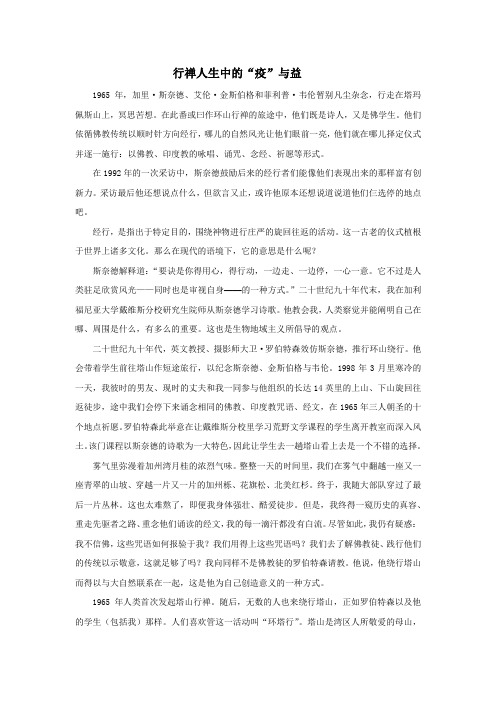
行禅人生中的“疫”与益1965年,加里·斯奈德、艾伦·金斯伯格和菲利普·韦伦暂别凡尘杂念,行走在塔玛佩斯山上,冥思苦想。
在此番或曰作环山行禅的旅途中,他们既是诗人,又是佛学生。
他们依循佛教传统以顺时针方向经行,哪儿的自然风光让他们眼前一亮,他们就在哪儿择定仪式并逐一施行:以佛教、印度教的咏唱、诵咒、念经、祈愿等形式。
在1992年的一次采访中,斯奈德鼓励后来的经行者们能像他们表现出来的那样富有创新力。
采访最后他还想说点什么,但欲言又止,或许他原本还想说道说道他们仨选停的地点吧。
经行,是指出于特定目的,围绕神物进行庄严的旋回往返的活动。
这一古老的仪式植根于世界上诸多文化。
那么在现代的语境下,它的意思是什么呢?斯奈德解释道:“要诀是你得用心,得行动,一边走、一边停,一心一意。
它不过是人类驻足欣赏风光——同时也是审视自身——的一种方式。
”二十世纪九十年代末,我在加利福尼亚大学戴维斯分校研究生院师从斯奈德学习诗歌。
他教会我,人类察觉并能阐明自己在哪、周围是什么,有多么的重要。
这也是生物地域主义所倡导的观点。
二十世纪九十年代,英文教授、摄影师大卫·罗伯特森效仿斯奈德,推行环山绕行。
他会带着学生前往塔山作短途旅行,以纪念斯奈德、金斯伯格与韦伦。
1998年3月里寒冷的一天,我彼时的男友、现时的丈夫和我一同参与他组织的长达14英里的上山、下山旋回往返徒步,途中我们会停下来诵念相同的佛教、印度教咒语、经文,在1965年三人朝圣的十个地点祈愿。
罗伯特森此举意在让戴维斯分校里学习荒野文学课程的学生离开教室而深入风土。
该门课程以斯奈德的诗歌为一大特色,因此让学生去一趟塔山看上去是一个不错的选择。
雾气里弥漫着加州湾月桂的浓烈气味。
整整一天的时间里,我们在雾气中翻越一座又一座青翠的山坡、穿越一片又一片的加州栎、花旗松、北美红杉。
终于,我随大部队穿过了最后一片丛林。
这也太难熬了,即便我身体强壮、酷爱徒步。
第二十二届韩素音青年翻译奖竟赛英译汉译文和译文评析

英译汉Hidden Within Technology’s Empire, a Republic of Letters隐藏于技术帝国的文学界索尔•贝妻When I was a boy “discovering literature”, I used to think how wonderful it would be if every other person on the street were familiar with Proust and Joyce or T. E. Lawrence or Pasternak and Kafka. Later I learned how refractory to high culture the democratic masses were. Lincoln as a young frontiersman read Plutarch, Shakespeare and the Bible. But then he was Lincoln.我还是个"探索文学"的少年时,就经常在想:要是大街上人人都熟悉普鲁斯特和乔伊斯,熟悉T.E.劳伦斯,熟悉帕斯捷尔纳克和卡夫卡,该有多好啊!后来才知道,平民百姓对高雅文化有多排斥。
虽说少年时代身居边陲的林肯就在阅读普鲁塔克,、莎士比亚和《圣经》,但他毕竟是林肯。
Later when I was traveling in the Midwest by car, bus and train, I regularly visited small-town libraries and found that readers in Keokuk, Iowa, or Benton Harbor, Mich., were checking out Proust and Joyce and even Svevo and Andrei Biely. D. H. Lawrence was also a favorite. And sometimes I remembered that God was willing to spare Sodom for the sake of 10 of the righteous. Not that Keokuk was anything like wicked Sodom, or that Proust’s Charlus would have been tempted to settle in Benton Harbor, Mich. I seem to have had a persistent democratic desire to find evidences of high culture in the most unlikely places.后来,我坐小车、巴士和火车在中西部旅行,经常走访小镇图书馆;发现在衣阿华州基奥卡克市,或者密歇根州本顿港市,读者们借阅普鲁斯特和乔伊斯的作品,甚至还有斯维沃@和安德烈•别雷®的著作。
第22届韩素音翻译大赛 英译汉 参考译文
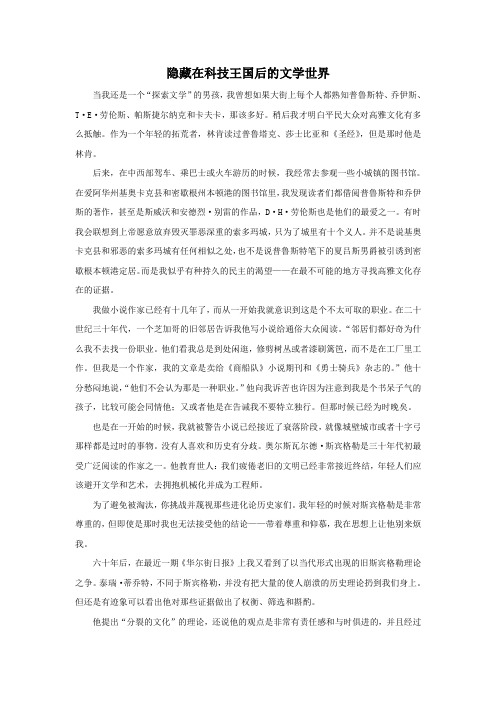
隐藏在科技王国后的文学世界当我还是一个“探索文学”的男孩,我曾想如果大街上每个人都熟知普鲁斯特、乔伊斯、T·E·劳伦斯、帕斯捷尔纳克和卡夫卡,那该多好。
稍后我才明白平民大众对高雅文化有多么抵触。
作为一个年轻的拓荒者,林肯读过普鲁塔克、莎士比亚和《圣经》,但是那时他是林肯。
后来,在中西部驾车、乘巴士或火车游历的时候,我经常去参观一些小城镇的图书馆。
在爱阿华州基奥卡克县和密歇根州本顿港的图书馆里,我发现读者们都借阅普鲁斯特和乔伊斯的著作,甚至是斯威沃和安德烈·别雷的作品,D·H·劳伦斯也是他们的最爱之一。
有时我会联想到上帝愿意放弃毁灭罪恶深重的索多玛城,只为了城里有十个义人。
并不是说基奥卡克县和邪恶的索多玛城有任何相似之处,也不是说普鲁斯特笔下的夏吕斯男爵被引诱到密歇根本顿港定居。
而是我似乎有种持久的民主的渴望——在最不可能的地方寻找高雅文化存在的证据。
我做小说作家已经有十几年了,而从一开始我就意识到这是个不太可取的职业。
在二十世纪三十年代,一个芝加哥的旧邻居告诉我他写小说给通俗大众阅读。
“邻居们都好奇为什么我不去找一份职业。
他们看我总是到处闲逛,修剪树丛或者漆刷篱笆,而不是在工厂里工作。
但我是一个作家,我的文章是卖给《商船队》小说期刊和《勇士骑兵》杂志的。
”他十分愁闷地说,“他们不会认为那是一种职业。
”他向我诉苦也许因为注意到我是个书呆子气的孩子,比较可能会同情他;又或者他是在告诫我不要特立独行。
但那时候已经为时晚矣。
也是在一开始的时候,我就被警告小说已经接近了衰落阶段,就像城壁城市或者十字弓那样都是过时的事物。
没有人喜欢和历史有分歧。
奥尔斯瓦尔德·斯宾格勒是三十年代初最受广泛阅读的作家之一。
他教育世人:我们疲倦老旧的文明已经非常接近终结,年轻人们应该避开文学和艺术,去拥抱机械化并成为工程师。
为了避免被淘汰,你挑战并蔑视那些进化论历史家们。
韩素音翻译大赛英译汉
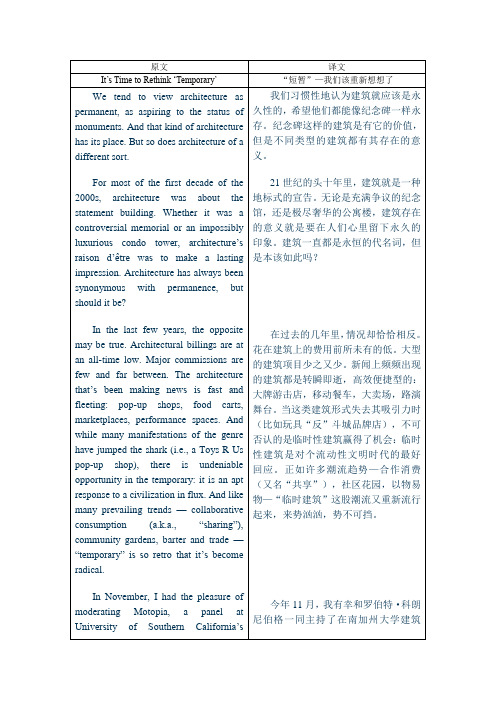
原文
译文
It’s Time to Rethink ‘Temporary’
“短暂”—我们该重新想想了
We tend to view architecture as permanent, as aspiring to the status of monuments. And that kind of architecture has its place. But so does architecture of a different sort.
In November, I had the pleasure of moderatingMSouthern California’sSchool of Architecture, with Robert Kronenburg, an architect, professor at University of Liverpool and portable/temporary/mobile guru. Author of a shelf full of books on the topic, including “Flexible: Architecture that Responds to Change,” “Portable Architecture: Design and Technology” and “Houses in Motion: The Genesis,” Kronenburg is a man obsessed.
韩素音翻译原文(1)
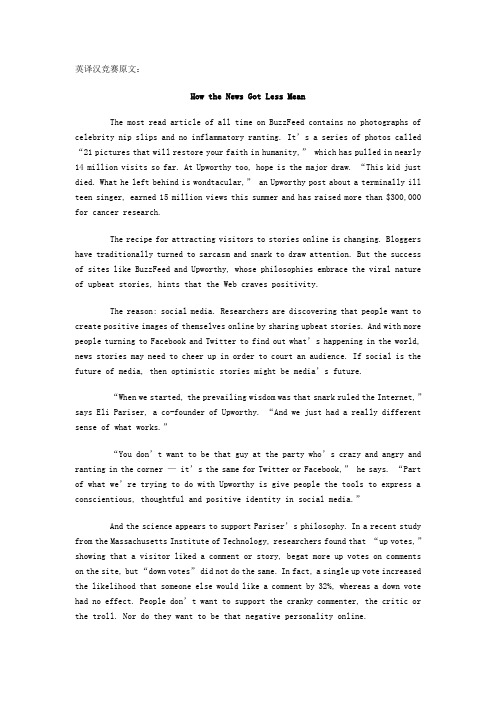
英译汉竞赛原文:How the News Got Less MeanThe most read article of all time on BuzzFeed contains no photographs of celebrity nip slips and no inflammatory ranting. It’s a series of photos called “21 pictures that will restore your faith in humanity,” which has pulled in nearly 14 million visits so far. At Upworthy too, hope is the major draw. “This kid just died. What he left behind is wondtacular,” an Upworthy post about a terminally ill teen singer, earned 15 million views this summer and has raised more than $300,000 for cancer research.The recipe for attracting visitors to stories online is changing. Bloggers have traditionally turned to sarcasm and snark to draw attention. But the success of sites like BuzzFeed and Upworthy, whose philosophies embrace the viral nature of upbeat stories, hints that the Web craves positivity.The reason: social media. Researchers are discovering that people want to create positive images of themselves online by sharing upbeat stories. And with more people turning to Facebook and Twitter to find out what’s happening in the world, news stories may need to cheer up in order to court an audience. If social is the future of media, then optimistic stories might be media’s future.“When we started, the prevailing wisdom was that snark ruled the Internet,”says Eli Pariser, a co-founder of Upworthy. “And we just had a really different sense of what works.”“You don’t want to be that guy at the party who’s crazy and angry and ranting in the corner — it’s the same for Twitter or Facebook,” he says. “Part of what we’re trying to do with Upworthy is give people the tools to express a conscientious, thoughtful and positive identity in social media.”And the science appears to support Pariser’s philosophy. In a recent study from the Massachusetts Institute of Technology, researchers found that “up votes,”showing that a visitor liked a comment or story, begat more up votes on comments on the site, but “down votes” did not do the same. In fact, a single up vote increased the likelihood that someone else would like a comment by 32%, whereas a down vote had no effect. People don’t want to support the cranky commenter, the critic or the troll. Nor do they want to be that negative personality online.In another study published in 2012, Jonah Berger, author of Contagious: Why Things Catch On and professor of marketing at the Wharton School of the University of Pennsylvania, monitored the most e-mailed stories produced by the New York Times for six months and found that positive stories were more likely to make the list than negative ones.“What we share [or like] is almost like the car we drive or the clothes we wear,”he says. “It says something about us to other people. So people would much rather be seen as a Positive Polly than a Debbie Downer.”It’s not always that simple: Berger says that though positive pieces drew more traffic than negative ones, within the categories of positive and negative stories, those articles that elicited more emotion always led to more shares.“Take two negative emotions, for example: anger and sadness,” Berger says. “Both of those emotions would make the reader feel bad. But anger, a high arousal emotion, leads to more sharing, whereas sadness, a low arousal emotion, doesn’t. The same is true of the positive side: excitement and humor increase sharing, whereas contentment decreases sharing.”And while some popular BuzzFeed posts — like the recent “Is this the most embarrassing interview Fox News has ever done?”— might do their best to elicit shares through anger, both BuzzFeed and Upworthy recognize that their main success lies in creating positive viral material.“It’s not that people don’t share negative stories,” says Jack Shepherd, editorial director at BuzzFeed. “It just means that there’s a higher potential for positive stories to do well.”Upworthy’s mission is to highlight serious issues but in a hopeful way, encouraging readers to donate money, join organizations and take action. The strategy seems to be working: barely two years after its launch date (in March 2012), the site now boasts 30 million unique visitors per month, according to Upworthy. The site’s average monthly unique visitors grew to 14 million people over its first six quarters — to put that in perspective, the Huffington Post had only about 2 million visitors in its first six quarters online.But Upworthy measures the success of a story not just by hits. The creators of the site only consider a post a success if it’s also shared frequently on social media. “We are interested in content that people want to share partly for pragmaticreasons,” Pariser says. “If you don’t have a good theory about how to appear in Facebook and Twitter, then you may disappear.”Nobody has mastered the ability to make a story go viral like BuzzFeed. The site, which began in 2006 as a lab to figure out what people share online, has used what it’s learned to draw 60 million monthly unique visitors, according to BuzzFeed. (Most of that traffic comes from social-networking sites, driving readers toward BuzzFeed’s mix of cute animal photos and hard news.) By comparison the New York Times website, one of the most popular newspaper sites on the Web, courts only 29 million unique visitors each month, according to the Times.BuzzFeed editors have found that people do still read negative or critical stories, they just aren’t the posts they share with their friends. And those shareable posts are the ones that newsrooms increasingly prize.“Anecdotally, I can tell you people are just as likely to click on negative stories as they are to click on positive ones,” says Shepherd. “But they’re more likely to share positive stories. What you’re interested in is different from what you want your friends to see what you’re interested in.”So as newsrooms re-evaluate how they can draw readers and elicit more shares on Twitter and Facebook, they may look to BuzzFeed’s and Upworthy’s happiness model for direction.“I think that the Web is only becoming more social,” Shepherd says. “We’re at a point where readers are your publishers. If news sites aren’t thinking about what it would mean for someone to share a story on social media, that could be detrimental.”汉译英竞赛原文:城市的迷失沿着瑗珲—腾冲线,这条1935年由胡焕庸先生发现并命名的中国人口、自然和历史地理的分界线,我们看到,从远距离贸易发展开始的那天起,利益和权力的渗透与分散,已经从根本结构上改变了城市的状态:城市在膨胀,人在疏离。
第28届韩素音翻译比赛汉译英原文和参考译文(下)
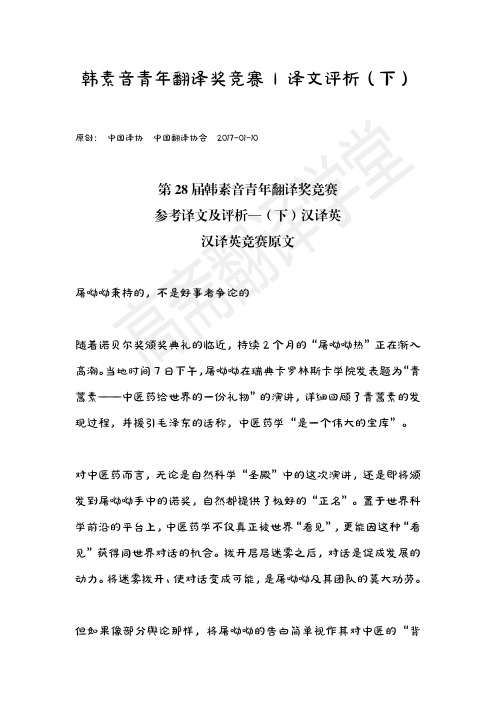
韩素音青年翻译奖竞赛 | 译文评析(下) 原创: 中国译协 中国翻译协会 2017-01-10第28届韩素音青年翻译奖竞赛参考译文及评析—(下)汉译英汉译英竞赛原文屠呦呦秉持的,不是好事者争论的随着诺贝尔奖颁奖典礼的临近,持续2个月的“屠呦呦热”正在渐入高潮。
当地时间7日下午,屠呦呦在瑞典卡罗林斯卡学院发表题为“青蒿素——中医药给世界的一份礼物”的演讲,详细回顾了青蒿素的发现过程,并援引毛泽东的话称,中医药学“是一个伟大的宝库”。
对中医药而言,无论是自然科学“圣殿”中的这次演讲,还是即将颁发到屠呦呦手中的诺奖,自然都提供了极好的“正名”。
置于世界科学前沿的平台上,中医药学不仅真正被世界“看见”,更能因这种“看见”获得同世界对话的机会。
拨开层层迷雾之后,对话是促成发展的动力。
将迷雾拨开、使对话变成可能,是屠呦呦及其团队的莫大功劳。
但如果像部分舆论那样,将屠呦呦的告白简单视作其对中医的“背书”,乃至将其成就视作中医向西医下的“战书”,这样的心愿固然可嘉,却可能完全背离科学家的本意。
听过屠呦呦的报告,或是对其研究略作了解就知道,青蒿素的发现既来自于中医药“宝库”提供的积淀和灵感,也来自于西医严格的实验方法。
缺了其中任意一项,历史很可能转向截然不同的方向。
换言之,在“诺奖级”平台上促成中西医对话之前,屠呦呦及其团队的成果,正是长期“对话”的成果。
而此前绵延不绝的“中西医”之争,多多少少都游离了对话的本意,而陷于一种单向化的“争短长”。
持中医论者,不屑于西医的“按部就班”;持西医论者,不屑于中医的“随心所欲”。
双方都没有看到,“按部就班”背后本是实证依据,“随心所欲”背后则有文化内涵,两者完全可以兼容互补,何必非得二元对立?屠呦呦在演讲中坦言,“通过抗疟药青蒿素的研究历程,我深深地感到中西医药各有所长,两者有机结合,优势互补,当具有更大的开发潜力和良好的发展前景”。
这既是站在中医药立场上对西方科学界的一次告白,反过来也可理解为西医立场上对中医拥趸们的提醒。
第十二届“韩素音青年翻译奖”竞赛原文及参考译文(汉译英)
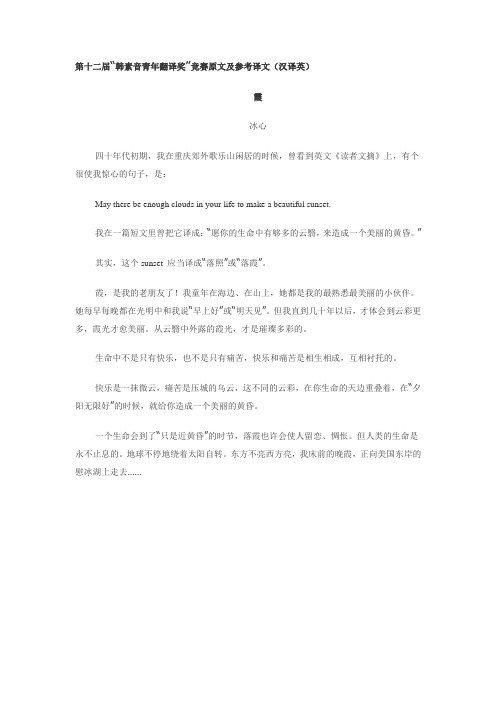
第十二届“韩素音青年翻译奖”竞赛原文及参考译文(汉译英)霞冰心四十年代初期,我在重庆郊外歌乐山闲居的时候,曾看到英文《读者文摘》上,有个很使我惊心的句子,是:May there be enough clouds in your life to make a beautiful sunset.我在一篇短文里曾把它译成:“愿你的生命中有够多的云翳,来造成一个美丽的黄昏。
”其实,这个sunset 应当译成“落照”或“落霞”。
霞,是我的老朋友了!我童年在海边、在山上,她都是我的最熟悉最美丽的小伙伴。
她每早每晚都在光明中和我说“早上好”或“明天见”。
但我直到几十年以后,才体会到云彩更多,霞光才愈美丽。
从云翳中外露的霞光,才是璀璨多彩的。
生命中不是只有快乐,也不是只有痛苦,快乐和痛苦是相生相成,互相衬托的。
快乐是一抹微云,痛苦是压城的乌云,这不同的云彩,在你生命的天边重叠着,在“夕阳无限好”的时候,就给你造成一个美丽的黄昏。
一个生命会到了“只是近黄昏”的时节,落霞也许会使人留恋、惆怅。
但人类的生命是永不止息的。
地球不停地绕着太阳自转。
东方不亮西方亮,我床前的晚霞,正向美国东岸的慰冰湖上走去……The Rosy CloudBingxinDuring the early 1940s I was living a retired life in the Gele Mountains in the suburbs of Chongqing (Chungking). One day, while reading the English language magazine Reader's Digest I found a sentence that touched me greatly. It read: "May there be enough clouds in your life to make a beautiful sunset."In a short article of mine, I quoted this sentence and translated it as "Yuan ni de shengming zhong you guo duo de yunyi, lai zaocheng yige meili de huanghun. " (literally: May there be enough clouds in your life to make a beautiful sunset.) *As I see it now, the word "sunset" in the English sentence should have been translated as luozhao (the glow at sunset) or luoxia (the rosy cloud at sunset), instead of dusk.She has been my dear old friend, the Rosy Cloud! She was my closest and most beautiful little companion when, in my childhood, I played on the beach or in the hills. Bathed in the brilliant sunshine, she would say to me "Good morning!" at dawn and "See you tomorrow!" at dusk. But not until several decades later did I come to realize that the more clouds there are the more beautiful the rays of sunlight will be, and the glow of the sun breaking through the clouds becomes most resplendent and colorful.Life contains neither unalloyed happiness nor mere misery. Happiness and misery beget, complement and set off each other.Happiness is a wisp of fleecy cloud; misery a mass of threatening dark cloud. These different clouds overlap on the horizon of your life to create a beautiful dusk for you when "the setting sun is most lovely indeed."**An individual's life must inevitably reach the point when "dusk is so near,"*** and the rosy sunset cloud may make one nostalgic and melancholy. But human life goes on and on. The Earth ceaselessly rotates on its axis around the sun. When it is dark in the east, it is light in the west. The rosy sunset cloud is now sailing past my window towards Lake Waban on the east coast of America ...*This sentence appears in Chinese and English in the article "For Young Readers Again, Newsletter No.4", written by Bing Xin in the Gele Mountains, on December 1, 1944.** and *** These two poetic lines are taken from a poem "On the Plain of Tombs" by Li Shangyin (813-858), a well-known poet of the Tang Dynasty (618-907). The two lines read like this: "The setting sun appears sublime, / But O! 'Tis near its dying time." (Tr. Xu Yuanchong) They imply that the setting sun has infinite beauty, but it is a pity that it is near the dusk, and the beautiful scene cannot last long. The two lines are often used to deplore the ephemeral nature of things, and to express the feelings at the loss of past glory and at the advent of old age.。
韩素音译文

恰逢其时:对“临时性”的再考量我们往往会认为建筑物就该是永久性的,甚至希望达到与纪念碑相提并论的地位。
此类建筑固然占有一席之地,但另一类建筑同样有其存在的价值。
在21世纪头十年的大部分时间里,建筑艺术就是要使建筑物起到某种昭示作用。
无论是颇具争议的纪念碑,还是奢华程度令人难以想象的公寓大厦,建筑存在的理由就是要给人留下难以磨灭的印象。
建筑从来就是“永久性”的同义词,但是,它果真应该是如此吗?在过去的几年中,实际情形也许恰恰相反。
建筑业的经济效益可以说是空气的不景气,承担大型建筑项目的机会寥寥无几,而那些备受媒体瞩目的建筑也是来去匆匆,像游击商店、食品车、市场、演出场地等。
虽然许多此类风格的建筑早已成明日黄花(如玩具“反”斗游击店),但临时性建筑的机遇是不可否认的:这是对日新月异的文明现象的恰当回应。
就如同合作消费(或“分享制”)、社区田园、易物交易等许多流行的做法那样,“临时性”建筑如此趋于回归,俨然非同一般,令人刮目相看。
我有幸在11月份同罗伯特·克罗能伯格(Robert Kronenburg)一道主持了南加州大学建筑学院的“移动乌托邦”小型研讨会。
克罗能伯格是一名建筑师,利物浦大学的教授,是研究便携式、临时性、移动型建筑的权威人士。
他在该领域著作等身,其中有《变通性:应对变化的建筑风格》,《便携式建筑:设计与技术》,《移动房屋的起源》,可谓浸淫其中。
克罗能伯格认为,可移动性有一种内在的生发力。
既然可移动的环境要比静止的更具有活力,为什么建筑物就非得静止不动呢?或许并非所有的建筑物都应追求永恒,这一观点标志着建筑设计的巨大转变。
摆脱了传统的束缚,建筑师、设计师、建造者和开发商就能更快地利用当前新技术之长,并付诸实施。
建筑是可再利用,可循环,可持续的。
以此方式重新定位和着手,一些看似解决不了的问题就可能迎刃而解,这样的建筑物仍能给人们带来身临实地的感觉。
克罗能伯格发言时举例说明了便携式、临时性的建筑早已运用于人类活动的各个方面,包括医疗(从弗罗伦斯·南丁格尔重新设计的医院到肯尼迪执政期间被用作流动医疗诊所的“清风”拖挂房车等)、住房(从蒙古包到帐篷,再到建筑师坂茂设计的震后纸板房),还有文化与商业(如各种舞台布景、万国工业博览会的各种建筑、塞纳河畔的那些百年流动旧书摊、移动餐饮店、艺术与音乐场所,这些场所提供各种商品,从录音故事到可口的焦糖奶油布丁,一应俱全)。
准确理解审慎表达_第十二届_韩素音青年翻译奖_英译汉参赛译文评析
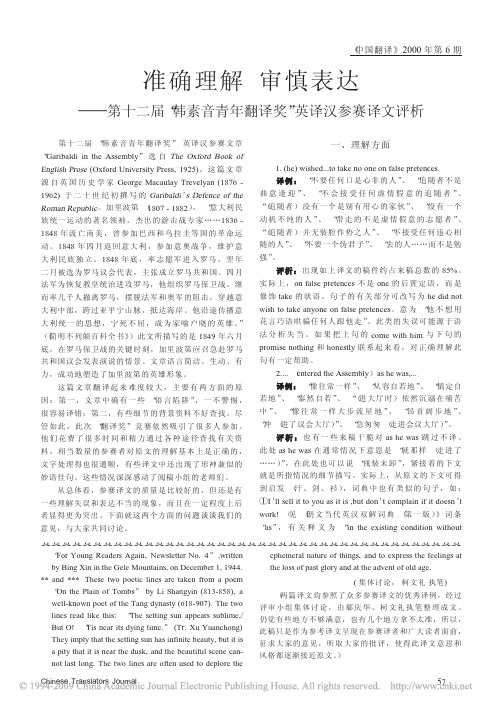
“ 不要任何口是心非的人” 、 “ 追随者不是 曲意逢迎” 、 “ 不会接受任何虚情假意的追随者” 、 “ ( 追随者)没有一个 是 别 有 用 心 的 家 伙 ” 、 “ 没有一个 动机不纯的人” 、 “ 带走的不是虚情假意的志愿者” 、 “ ( 追随者)并无装腔 作 势 之 人 ” 、 “ 不接受任何违心相 随的人” 、 “ 不要一个伪君子” 、 “ 去的人……而不是勉 强” 。 出现 如 上 译 文 的 稿 件 约 占 来 稿 总 数 的 IDS 。 实 际 上 , 8,+7%)1/+N&/-/,G/1 不 是 8,/ 的 后 置 定 语 , 而 是 修 饰 -%:/ 的 状 语 。 句 子 的 有 关 部 分 可 改 写 为 ./+*’*+,8-+ 他不想用 R’1.+-8+-%:/+%,38,/+8,+7%)1/+N&/-/,G/1 。 意 为 “ 花言巧语哄骗任 何 人 跟 他 走 ” 。此类的失误可能源于语 法 分 析 失 当 。 如 果 把 上 句 的 G82/+ R’-.+.’2 与 下 句 的
《 中国翻译》!""" 年第 # 期
准确理解 审慎表达
—第十二届“ —— 韩素音青年翻译奖” 英译汉参赛译文评析
第十二届 “ 韩素音青年翻译奖” 英译汉参赛文章 “ $%&’(%)*’+ ’,+ -./+ 011/2()3 ” 选 自 4./ 5678&* 988: 87
28届韩素音杯竞赛原文
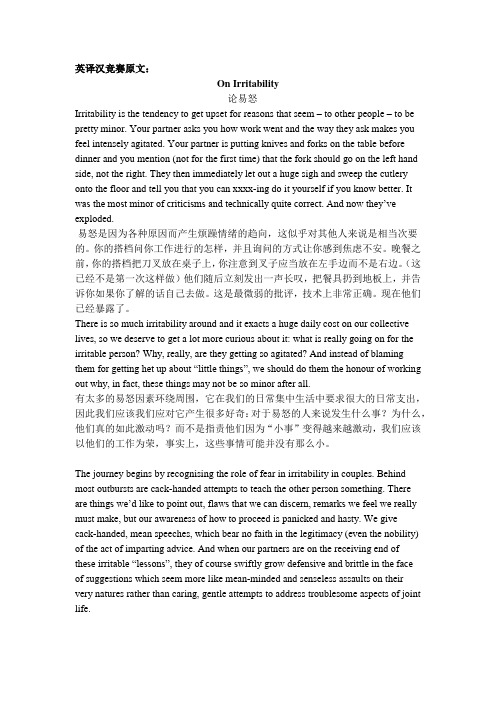
英译汉竞赛原文:On Irritability论易怒Irritability is the tendency to get upset for reasons that seem – to other people – to be pretty minor. Your partner asks you how work went and the way they ask makes you feel intensely agitated. Your partner is putting knives and forks on the table before dinner and you mention (not for the first time) that the fork should go on the left hand side, not the right. They then immediately let out a huge sigh and sweep the cutlery onto the floor and tell you that you can xxxx-ing do it yourself if you know better. It was the most minor of criticisms and technically quite correct. And now they’ve exploded.易怒是因为各种原因而产生烦躁情绪的趋向,这似乎对其他人来说是相当次要的。
你的搭档问你工作进行的怎样,并且询问的方式让你感到焦虑不安。
晚餐之前,你的搭档把刀叉放在桌子上,你注意到叉子应当放在左手边而不是右边。
(这已经不是第一次这样做)他们随后立刻发出一声长叹,把餐具扔到地板上,并告诉你如果你了解的话自己去做。
这是最微弱的批评,技术上非常正确。
现在他们已经暴露了。
2010年第22届韩素音青年翻译大赛–汉译英,实验版译文
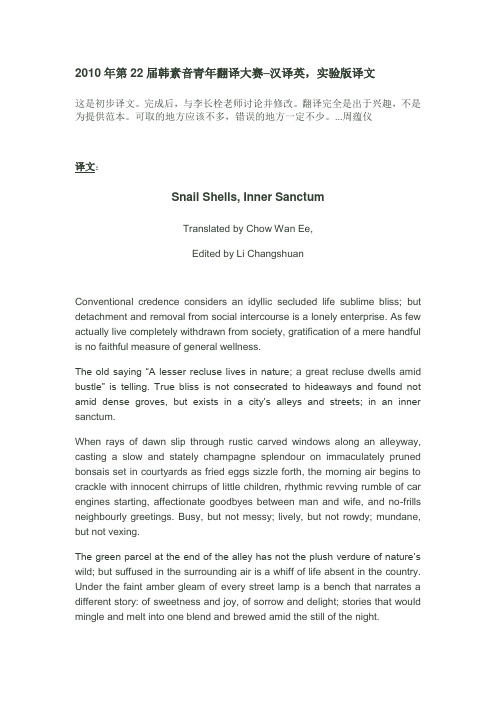
2010年第22届韩素音青年翻译大赛–汉译英,实验版译文这是初步译文。
完成后,与李长栓老师讨论并修改。
翻译完全是出于兴趣,不是为提供范本。
可取的地方应该不多,错误的地方一定不少。
...周蕴仪译文:Snail Shells, Inner SanctumTranslated by Chow Wan Ee,Edited by Li ChangshuanConventional credence considers an idyllic secluded life sublime bliss; but detachment and removal from social intercourse is a lonely enterprise. As few actually live completely withdrawn from society, gratification of a mere handful is no faithful measure of general wellness.The old saying “A lesser recluse lives in nature; a great recluse dwells amid bustle” is telling. True bliss is not consecrated to hideaways and found not amid dense groves, but exists in a city’s alleys and streets; in an inner sanctum.When rays of dawn slip through rustic carved windows along an alleyway, casting a slow and stately champagne splendour on immaculately pruned bonsais set in courtyards as fried eggs sizzle forth, the morning air begins to crackle with innocent chirrups of little children, rhythmic revving rumble of car engines starting, affectionate goodbyes between man and wife, and no-frills neighbourly greetings. Busy, but not messy; lively, but not rowdy; mundane, but not vexing.The green parcel at the end of the alley has not the plush verdure of nature’s wild; but suffused in the surrounding air is a whiff of life absent in the country. Under the faint amber gleam of every street lamp is a bench that narrates a different story: of sweetness and joy, of sorrow and delight; stories that would mingle and melt into one blend and brewed amid the still of the night.No one knows what pleasant surprise is waiting at the next turn of corner. An unusual and always-crowded eatery? A pub that lives and breathes jazz music?A little coffee joint with wooden bar stools and an atmosphere of languorous leisure? Perhaps sitting outdoors on a timber chair under a parasol chatting with new-found friends over a cup of tea is pleasure.Things, when shaped and sedimented by time, conciliate into habits, intuitive knowing, and culture.When neighbours and friends who come by banter about petty matters and all with the same cunning wit, their squinting eyes would sparkle with wicked glints of intuitive knowing; at the dinner table, family members mouths muzzled with food cackling indistinguishable utterances may be a little loud, but no one takes offence.Alleys may be narrow, but narrowness cannot stall the spread of happiness; yet, as cold concrete jungles emerge, bliss is slowly devoured and taken apart by traffic congestion and polluted air. Homes are bigger and privacy better; and Self is now confined to a solitary enclosure, carefully avoiding infringing the inner world of another, and jealously guarding its own. But during quiet moments of solitude, the once deplored clamour would be dearly missed and fondly reminisced.Compared to Manhattan high-rises, people prefer the sun-basked ancient streets traversing under the massive red dome of the Duomo of Florence; compared to the nightly resplendence of Lujiazui, people prefer the romp and stomp of children’s play at Wanhangdu Road. As our years wither away, dreams would return to find the sombre calm of old houses, the soft choruses of street vendors, and that little alley that had dowered endearing recollections.Discernment would reveal, in every corner inhabited by wisps of moss and vines of ivy, genuine poetry and prose that are neither graceful nor spirited, but that offer mundane bliss. Simple and easy bliss.What is bliss? This may not be a difficult question after all. Bliss is an open book of poetry about common alleys sauntering under city skies.As urban homes glitter and shimmer under the moon-lit expanse, one wonders how much mundane bliss lies within those “snail shells”, that inner sanctum…原文:蜗居在巷陌的寻常幸福隐逸的生活似乎在传统意识中一直被认为是幸福的至高境界。
韩素音翻译大赛英译汉原文解读与译赏(2020年7月整理).pdf

Globalization全球化颜林海【标题解读】写作分析:何谓全球化?回答这个问题的过程就是就是人类对客观事物的认识过程,即“定义”的过程,换句话说,“定义”就是界定一种事物的本质(即意义)的说明。
“定义”有许多方式,最常见的有:列举法(illustration),分类法(classification),过程分析法(process analysis),因果法(cause and effect),比对法(comparison and contrast);除了以上方法外,还有特征枚举法(enumerating characteristics),词源法(etymology),类比法(analogy),排除法(exclusion)(M.S. Spangler & R.Werner,1990:131—135)。
从写作或其他媒介的角度,作为一篇文章的标题,作者必然要围绕标题来展开,而要展开这个话题,就必须对该字词加以界定,即定义。
篇体分析:从上下文看,这是一篇由一档电视谈话节目转写而成的书面文档;电视访谈类节目虽然重在访谈,但并非人与人之间的私下闲聊,因此,节目主持人也往往会提前大致拟定一个围绕某一话题而展开的提纲,这就与文章写作大同而小异了。
理解与翻译时,注意访谈中人物对话的转换,还要注意书写文本在断句上与访谈情景有时并不一致,如(25)句。
翻译分析:在翻译之前,译者也应对标题中涉及到的概念加以认识和理解。
译者在分析某一核心字词时必须注意该字词的音形义的分析。
此篇文章中globalization与音没有多大关系,主要分析该字词的“形”和“义”。
而字“形”的分析涉及到该词的词源和构词方式。
词源分析:Globalization一词逆推词源关系如下:globalization。
构词分析:globalization不过是globalize的名词拼写形式,核心意义在globalize;而此词的构形属于英语中“形容词+动词后缀ize”构词法,其表达的意义为“使...‘形容词’化”或“使...变成‘形容词’”。
韩素音青年翻译

英译汉竞赛原文:The Posteverything GenerationI never expected to gain any new insight into the nature我从未想过要对我们这一代人的本质,of my generation, or the changing landscape of American 或者说在美国大学变化中的风景,colleges, in Lit Theory. Lit Theory is supposed to be the class 在理论上获得任何新的见解。
文学理论应该是where you sit at the back of the room with every other jaded 你和其他穿着sophomore wearing skinny jeans, thick-framed glasses, an 紧身牛仔裤和一件夸张的T恤,带着厚框眼镜和ironic tee-shirt and over-sized retro headphones, just waiting 超大号的复古耳机的疲惫不堪的学生们坐在教室的后排,等待for lecture to be over so you can light up a Turkish Gold and着讲座结束,然后你可以点亮一根土耳其黄金,walk to lunch while listening to Wilco. That’s pretty much 听着Wilco去吃中饭。
这也是the way I spent the course, too: through structuralism,我度过课程最好的方式:通过结构主义,formalism, gender theory, and post-colonialism, I was far too 形式主义,性别理论,后殖民主义,我相当busy shuffling through my Ipod to see what the patriarchal world 忙碌的通过我的iPod看资本主义order of capitalist oppression had to do with Ethan Frome. But 压迫的男权世界秩序跟伊坦。
变通调整照应全局_对第十二届_韩素音青年翻译奖_英译汉参考译文的几点补充意见
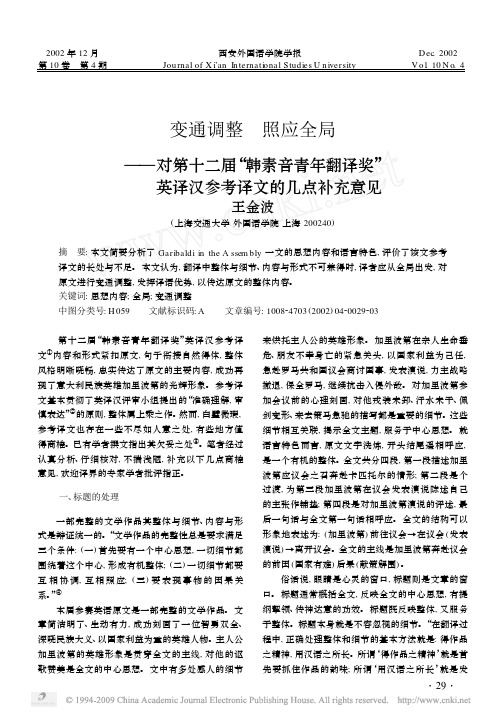
( 1) So re a t hea rt, and p reoccup ied by b itter though ts, he ga llop ed up to the Cap ito l, dism oun t2 ed, and en tered the A ssem b ly a s he w a s, h is red
fo r it p u t an end to a ll though t of b ringing fu rther
ru in on the bu ildings of Rom e. . . 参考译文: 总之, 他的演讲表现出英明的睿智和
高尚的气节; 它不但结束了使罗马建筑物遭受更大 破坏的想法, ……
参考译文: 加里波第怀着沉痛的心情和苦楚的 思绪, 驱马急驰上了卡匹托尔, 翻身下马, 戎装未卸, 就进了议会大厅, 身上的红衫沾满灰尘和血迹, 脸上 仍有从战场上带来的湿漉漉的汗水, 腰间的佩剑已 经弯曲, 半截露出鞘外。
这一段描写细腻生动、干净利落, 极富感染力。 开头两个修饰性短语 So re a t hea rt, and p reoccup ied by b itter though ts 相互对应, 工整匀称; 结尾三个伴 随性名词短语 h is red sh irt covered w ith du st and
本届参赛英语原文是一部完整的文学作品。 文 章简洁明了、生动有力, 成功刻画了一位智勇双全、 深晓民族大义、以国家利益为重的英雄人物。主人公 加里波第的英雄形象是贯穿全文的主线, 对他的讴 歌赞美是全文的中心思想。 文中有多处感人的细节
来烘托主人公的英雄形象。 加里波第在亲人生命垂 危、朋友不幸身亡的紧急关头, 以国家利益为己任, 急赴罗马共和国议会商讨国事, 发表演说, 力主战略 撤退, 保全罗马, 继续抗击入侵外敌。 对加里波第参 加会议前的心理刻画, 对他戎装未卸、汗水未干、佩 剑变形、来去策马急驰的描写都是重要的细节。这些 细节相互关联, 揭示全文主题, 服务于中心思想。 就 语言特色而言, 原文文字洗炼, 开头结尾遥相呼应, 是一个有机的整体。全文共分四段, 第一段描述加里 波第应议会之召奔赴卡匹托尔的情形; 第二段是个 过渡, 为第三段加里波第在议会发表演说陈述自己 的主张作铺垫; 第四段是对加里波第演说的评述, 最 后一句话与全文第一句话相呼应。 全文的结构可以 形象地表述为: (加里波第) 前往议会→在议会 (发表 演说) →离开议会。全文的主线是加里波第奔赴议会 的前因 (国家有难) 后果 (献策解围)。
评论译文
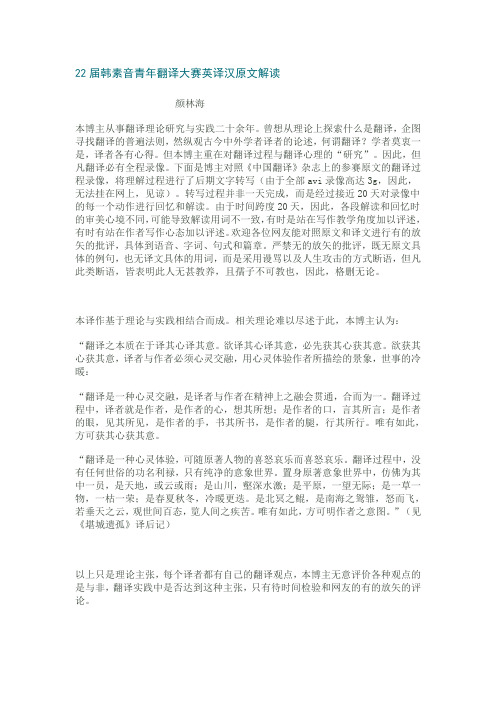
22届韩素音青年翻译大赛英译汉原文解读颜林海本博主从事翻译理论研究与实践二十余年。
曾想从理论上探索什么是翻译,企图寻找翻译的普遍法则,然纵观古今中外学者译者的论述,何谓翻译?学者莫衷一是,译者各有心得。
但本博主重在对翻译过程与翻译心理的“研究”。
因此,但凡翻译必有全程录像。
下面是博主对照《中国翻译》杂志上的参赛原文的翻译过程录像,将理解过程进行了后期文字转写(由于全部avi录像高达3g,因此,无法挂在网上,见谅)。
转写过程并非一天完成,而是经过接近20天对录像中的每一个动作进行回忆和解读。
由于时间跨度20天,因此,各段解读和回忆时的审美心境不同,可能导致解读用词不一致,有时是站在写作教学角度加以评述,有时有站在作者写作心态加以评述。
欢迎各位网友能对照原文和译文进行有的放矢的批评,具体到语音、字词、句式和篇章。
严禁无的放矢的批评,既无原文具体的例句,也无译文具体的用词,而是采用谩骂以及人生攻击的方式断语,但凡此类断语,皆表明此人无甚教养,且孺子不可教也,因此,格删无论。
本译作基于理论与实践相结合而成。
相关理论难以尽述于此,本博主认为:“翻译之本质在于译其心译其意。
欲译其心译其意,必先获其心获其意。
欲获其心获其意,译者与作者必须心灵交融,用心灵体验作者所描绘的景象,世事的冷暖:“翻译是一种心灵交融,是译者与作者在精神上之融会贯通,合而为一。
翻译过程中,译者就是作者,是作者的心,想其所想;是作者的口,言其所言;是作者的眼,见其所见,是作者的手,书其所书,是作者的腿,行其所行。
唯有如此,方可获其心获其意。
“翻译是一种心灵体验,可随原著人物的喜怒哀乐而喜怒哀乐。
翻译过程中,没有任何世俗的功名利禄,只有纯净的意象世界。
置身原著意象世界中,仿佛为其中一员,是天地,或云或雨;是山川,壑深水激;是平原,一望无际;是一草一物,一枯一荣;是春夏秋冬,冷暖更迭。
是北冥之鲲,是南海之鸳雏,怒而飞,若垂天之云,观世间百态,览人间之疾苦。
- 1、下载文档前请自行甄别文档内容的完整性,平台不提供额外的编辑、内容补充、找答案等附加服务。
- 2、"仅部分预览"的文档,不可在线预览部分如存在完整性等问题,可反馈申请退款(可完整预览的文档不适用该条件!)。
- 3、如文档侵犯您的权益,请联系客服反馈,我们会尽快为您处理(人工客服工作时间:9:00-18:30)。
蜗居在巷陌的寻常幸福
Simple Happiness of Dwelling in the Back Streets
隐逸的生活似乎在传统意识中一直被认为是幸福的至高境界。但这种孤傲遁世同时也是孤独的,纯粹的隐者实属少数,而少数者的满足不能用来解读普世的幸福模样。
But as dense, cold high-rises shoot up in the city, woefully accompanied by traffic congestion and air pollution, people’s happiness is little by little being eroded and lost. With more dwelling space and privacy, one has his “self” encircled in a solitary world, careful not to infringe on the souls of others, while also seeking not to be infringed upon. However, when one quiets down, the once tiresome hubbub now may evoke warm feelings and nostalgia.
Although the green patches at the end of the back streets are not so lushly verdant as those on the mountains, the urban air is permeated with a vitality lacking in the wilderness. Under pale yellow street lamps, each bench embodies diversified feelings—sweetness and happiness, joys and sorrows—all interwoven to slowly ferment in tranquility. No one knows what kind of pleasant surprise may be in store for him around the corner: a uniquely styled and busy cafe? Or a bar emitting jazz music? Or a coffee
和来家中做客的邻居朋友用同一种腔调巧妙地笑谑着身边的琐事,大家眯起的眼睛都默契地闪着同一种狡黠;和家人一起围在饭桌前,衔满食物的嘴还发着含糊的声音,有些聒噪,但没人厌烦。
When neighbors and friends come, they share witty jokes about personal trivialities, implicitly understanding each other's eye movements of like astuteness. Family members sit around the dining table, chattering through mouthfuls of food, and no one is bothered by the noise.
一切,被时间打磨,被时间沉淀,终于形成了一种习惯,一种默契,一种文化。
All these elements, tempered and deposited by time, settled finally into a custom, a tacit understanding and a culture.
如果用一双细腻的眼眸去观照,其实每一片青苔和爬山虎占据的墙角,都是墨绿色的诗篇,不会飘逸,不
会豪放,只是那种平淡的幸福,简简单单。
If observed with a perceptive eye, every inch of the walls and corners adorned with moss and ivy becomes a verdurous poem, which, neither elegant nor powerful, represents plain and simple happiness.
巷尾的绿地虽然没有山野的苍翠欲滴,但是空气中弥漫着荒野中所没有的生机。微黄的路灯下,每一张长椅都写着不同的心情,甜蜜与快乐、悲伤与喜悦,交织在一起,在静谧中缓缓发酵。谁也不会知道在下一个转角中会是怎样的惊喜,会是一家风格独特食客不断的小吃店?是一家放着爵士乐的酒吧?还是一家摆着高脚木凳、连空气都闲散的小小咖啡馆?坐在户外撑着遮阳伞的木椅上,和新认识的朋友一边喝茶,一边谈着自己小小的生活,或许也是一种惬意。
A secluded life has traditionally been deemed, as it seems, the supreme state of happiness, although such aloofness and retirement breed loneliness as well. Few people in fact end up as genuine recluses, whose contentment does not suffice to construe what happiness is for all.
幸福是什么模样,或许并不难回答。幸福就是一本摊开的诗篇,关于在城市的天空下,那些寻常巷陌的诗。
Perhaps it is not so difficult to define happiness after all. Happiness is an unfurled scroll of poems, describing ordinary alleys under the city skies.
夜幕笼罩,那散落一地的万家灯火中,有多少寻常的幸福正蜗居在巷陌……
No one knows how much simple happiness is seeping through those back streets lit up by the scattered lamps as the night falls...
小巷虽然狭窄,却拉不住快乐蔓延的速度……
Those lanes, narrow as they may be, cannot hold back the pervading happiness...
随着城市里那些密集而冰冷的高楼大厦拔地而起,在拥堵的车流中,在污浊的空气里,人们的幸福正在一点点地破碎,飘零。大家住得越来越宽敞,越来越私密。自我,也被划进一个单独的空间里,小心地不去触碰别人的心灵,也不容许他人轻易介入。可是,一个人安静下来时会觉得,曾经厌烦的那些嘈杂回想起来很温情很怀念。
有道是小隐隐于野,大隐隐于市。真正的幸福并不隐逸,可以在街市而不是丛林中去寻找。
As a common saying goes, while the “lesser hermit” lives in seclusion in the country, the “greater hermit” does so in the city. Not necessarily in solitude does reside true happiness which can be found in busy streets rather than in the woods.
shop with tall stools and a relaxed atmosphere? Perhaps it is also satisfying just to sit outdoors on a wooden chair under a sunshade, chatting over a cup of tea about daily trifles wi伦萨的Cathedral of Santa Maria del Fiore (圣母百花大教堂)。据说该教堂是世界排名第三的大教堂,坐落在佛罗伦萨的中心地带.是佛罗伦萨最为著名的地标之一。圣母百花大教堂最为著名的是教堂圆顶.八角圆顶为红色,顶高31米,最大直径为43米,建成时是当时最大的圆顶,圆顶的正中为尖顶塔亭。
比起高楼耸立的曼哈顿,人们更加喜欢佛罗伦萨红色穹顶下被阳光淹没的古老巷道;比起在夜晚光辉璀璨的陆家嘴,人们会更喜欢充满孩子们打闹嬉笑的万航渡路。就算已苍然老去,支撑起梦境的应该是老房子暗灰的安详,吴侬软语的叫卖声,那一方氤氲过温馨和回忆的小弄堂。
To Manhattan with soaring skyscrapers, people prefer Florence with sun-bathed ancient alleys by the towering red dome (1); to Lujiazui with dazzling night lights, people prefer Wanhangdu Road with narrow lanes full of rollicking children. Even as one grows old, it is likely that his dreams would be embellished by the serenity of the grey old houses, the calls of vendors in a soft-toned local dialect, and the small lanes filled with soothing memories.
晨光,透过古色古香的雕花窗棂,给庭院里精致的盆景慢慢地化上一抹金黄的淡妆。那煎鸡蛋的“刺啦”声袅袅升起,空气中开始充斥着稚嫩的童音、汽车启动的节奏、夫妻间甜蜜的道别,还有邻居们简单朴素的问好。巷陌中的这一切,忙碌却不混乱,活泼却不嘈杂,平淡却不厌烦。
